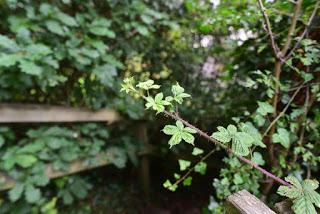
© Phil Pickin
I don’t know about you but brambles seem to be the bane of my life. That might be a slight exaggeration but living, as I do, on the side of a hill I seem to be surrounded by them and each time I walk past they seem to make a grab for whatever I’m wearing. I’m sure I’m not the only person who has called them many names other than blackberry, briar or their latin name, Rubus fruticosus, but what you may not know is that there are said to be over 300 micro species within the UK alone! This abundant and tenacious plant grows at an alarming speed. It seems that no sooner have I cleared a path of these spiky tendrils than they grow again. This can be more than just annoying as often I’ve been tripped up or have had the thorns rake across my shins! But no matter how much I dislike them brambles do have many redeeming qualities, and not just the crop of blackberries we will soon be enjoying.The tangles mass of thorn covered stems can cover large areas and within these many birds and animals find sanctuary. Low down within these areas rodents and small birds find protection from predators higher up the food chain as, like us, foxes etc find it hard and painful to negotiate these seemingly impenetrable refuges. Many birds nest within these areas and insects too find shelter and protection in established areas of brambles. The flowers provide pollen while the leaves can a provide both shelter and, eventually, leaf litter.In the autumn the humble blackberry redeems itself somewhat by producing the juicy berries we know and love, and it’s not just us humans that love the fruit. Birds especially make good use of this abundance of food, something that is essential to the bramble as it’s via the birds that the seeds are distributed. Once they are the new plant will grow almost everywhere making it a common sight in just about any habitat, from abandoned urban areas to railway embankments through to hillsides and just about any other location you care to mention. No doubt you will see them in abundance during your next walk.Over the years the bramble, and it’s fruit, have not only provided us with fruit to eat in pies etc but also fruit that can be turned into wine, jam, jellies and even ale (when mixed with malt and hops). Blackberries are high in vitamin C and its leaves have been used in herbal teas with, it is thought, detoxifying qualities. Dyes have been made from the fruit and even string can be made from the fibres of the stems (assuming you are brave enough to tackle such a thorny challenge).So, having done my research into a plant that seems to enjoy ripping my clothes, tripping me up and leaving painful scratches over any unprotected part of me, maybe I should be a little more tolerant. When you consider the benefits to both ourselves and the wildlife maybe I should forgive the occasional run in I have with it.

